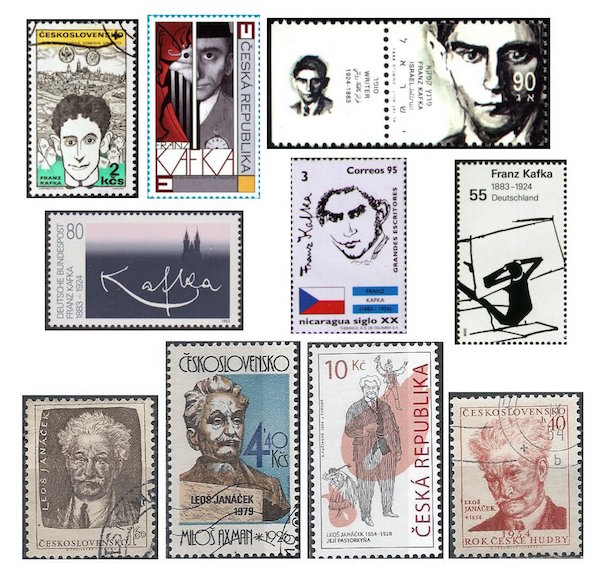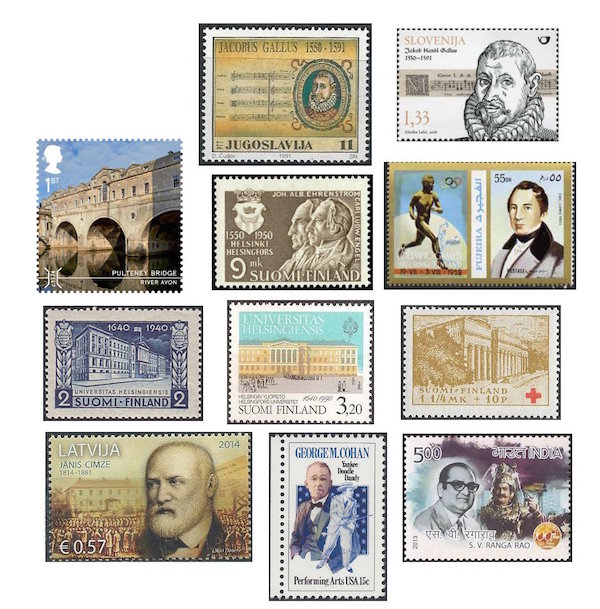The Arts on Stamps of the World — July 3
An Arts Fuse regular feature: the arts on stamps of the world.

By Doug Briscoe
Today’s edition of The Arts on Stamps of the World offers up Franz Kafka, John Singleton Copley, and Leoš Janáček as its headliners, with British architect Robert Adam, American song and dance man George M. Cohan, and three others on deck.
Franz Kafka (3 July 1883 – 3 June 1924) is said to have destroyed as much as 90% of his work, and we have his friend Max Brod to thank for saving the unfinished novels The Trial, The Castle, and Amerika, along with many other odds and ends, from the destruction Kafka expressly intended. Even without these, of course, Kafka’s immortality was assured, since many of his short pieces saw publication during his lifetime. But there might not be quite so many Kafka postage stamps today. There are two Czech examples (one from Czechoslovakia, the other from the Czech Republic), two from Germany, and one each from Israel and Brazil. As for musical adaptations, there are no fewer than three recent operas on Kafka: In the Penal Colony (2000) by Philip Glass, Kafka’s Trial (2005) by Poul Ruders, and Café Kafka (2014) by Francisco Coll.
Let us move on to Kafka’s countryman Leoš Janáček (3 July 1854 – 12 August 1928). For the great composer Czechoslovakia issued three stamps (1953, 1954, 1982) and the Czech Republic one so far (in 2004). Most of Janáček’s greatest works were written (in his unmistakable personal style) toward the end of his life in the 1920s: his four last operas, the Glagolitic (or Slavonic) Mass, the Sinfonietta, the Wind Sextet “Mládí (Youth)”, and both string quartets. A word about pronunciation: Czech words are almost invariably accented on the first syllable, so the accent mark over the second “a” indicates quantity, not stress (the first syllable is accented, the second is held a bit): thus LAY-osh YAH-naahh-check.

American painter John Singleton Copley (1738 – September 9, 1815), one of the artistic chroniclers of the period of the American Revolution, was born, probably in Boston, to a mother who owned a tobacco shop on Long Wharf. He left portraits of some of the central figures of the day, as well as of representatives of the middle class, historical paintings, and works in other genres. When the United States Postal Service memorialized him on a stamp in 1965, they chose not an historical central figure, but rather the central figure of his Portrait of the Copley Family (1776), his six-year-old daughter Betsy. To commemorate the bicentennial in 1976, the Maldive Islands put out a set of period paintings, three of which are portraits of John Hancock (1765), Paul Revere (1768-70), and Samuel Adams (1772). As for Copley’s grand historical paintings, the Isle of Jersey recalled his Death of Major Peirson (1783) on four se-tenant stamps. During the war, the French, allied with the Americans, attacked the Isle of Jersey, the strategic position of which was a constant threat to French and American shipping. Young Major Francis Peirson, only 24 at the time, was killed, as was the French commander. Copley also executed a few biblical and mythological pictures as well, as can be seen with his Mars, Venus, and Vulcan (1754) and Nativity (1776-77), shown on the U.S. Christmas stamp for the bicentennial year as well as on an Ivoirian issue.
Perhaps the most important British architect of the eighteenth century was Robert Adam (3 July 1728 – 3 March 1792), who was born and brought up in Scotland, where his father William Adam was the leading architect of the day. After a sound education, Robert set up shop with his brother John, which they later transferred to London. They designed not only buildings, but interiors and furniture, collaborating with Thomas Chippendale. The only stamp I could find for Adam, oddly enough, is one showing his 1774 construction, Pulteney Bridge, which crosses the River Avon in Bath, England.

It’s a bit ironic that Adam, for all his influence, has but a single stamp to his name while his fellow architect Carl Ludvig Engel (3 July 1778 – 14 May 1840) has five. He was born in Berlin but did all of his most important work, and a great deal of it there was, in Finland. His first employment was with the Prussian building administration, then because of the dislocation caused by the Napoleonic Wars, he moved on to Tallinn, Estonia and became town architect there. Commissions were slow in coming, however, and Engel got work in Turku, Finland, where he met Johan Albrecht Ehrenström, who was in charge of rebuilding Helsinki, which had suffered a great fire in 1808 and, moreover, had recently been named the capital of the new Grand Duchy of Finland. Though he hadn’t planned on it, Engel ended up remaining there for the rest of his life, being named head of the Intendant’s Office, which oversaw all the state buildings throughout the country, in 1824. The first Finnish stamp shows the two men together, Engel at right, and the other show two of Engel’s buildings for Helsinki, the University’s main building on stamps of 1940 and 1990, and the library on a stamp of 1932. The stamp from Fujeira was issued as part of a series looking back on Olympic history—it cites the 1952 Helsinki games and offers a portrait of Engel as one of the city’s major figures.
Jacobus Gallus (1550 – 18 July 1591) is one of those Renaissance composers known by various names: he was born in Carniola (today Slovenia), possibly as Jakob Petelin, which means “rooster”, as does the Latin Gallus and the German diminutive Handl. (Jacob/Jakob Handl/Händl/Handelius are other variants of his name, but the composer himself preferred the Latin version.) There is some uncertainty about his date of birth, with most sources I found agreeing on July 3rd. (Grove Online gives “between 15 April and 31 July 1550.”) He was a prolific composer of over 500 works, about 80% of them sacred, with most of them making up his gigantic Opus musicum of 1587, designed, with its 374 motets, to supply music for the entire liturgical year.

Jānis Cimze (born O.S. 21 June 1814, died 22 October [O.S. 10 October] 1881) is held to be the “father of Latvian choir music.” He assembled and harmonized a large collection of folk songs published in eight volumes in the 1870s and 80s. The stamp was issued three years ago today for the composer’s bicentenary. I got this image of the stamp directly from the Latvijas Pasts (Latvia Post) Website.
George M. Cohan (July 3, 1878 – November 5, 1942) really was, almost, a Yankee Doodle Dandy, born as he was on the Third of July. He was much more than a songwriter, singer, and dancer—he was also an actor, playwright, and producer. Composer of more than 300 songs and fifty musicals and plays, Cohan was born in Providence and toured in vaudeville with his family from early childhood. His most famous songs, besides “The Yankee Doodle Boy”, which was written for his first Broadway hit Little Johnny Jones (1904), include “Over There”, “Give My Regards to Broadway”, “Harrigan”, and “You’re a Grand Old Flag”. He was able to see James Cagney’s Cohan just prior to his death from abdominal cancer at age 64.
The Indian actor and director S. V. Ranga Rao (3 July 1918 – 18 July 1974) worked in Telugu and Tamil cinema. He was a method actor, and one of his signature roles was in the epic fantasy film Mayabazar (1957), called “greatest Indian film of all time” by a CNN-India Poll. His first appearance on the screen was in 1946, and thereafter worked in about 150 more. The two films he directed, Chadarangam (1967) and Bandhavyalu (1968), both took Nandi Awards, the ne plus ultra of Telugu cinema, television, and theater. Popularly known as S.V.R.—his full name was Samarla Venkata Ranga Rao—he died of a heart attack at 56.
A graduate of the University of Massachusetts with a B.A. in English, Doug Briscoe worked in Boston classical music radio, at WCRB, WGBH, and WBUR, for about 25 years, beginning in 1977. He has the curious distinction of having succeeded Robert J. Lurtsema twice, first as host of WGBH’s weekday morning classical music program in 1993, then as host of the weekend program when Robert J.’s health failed in 2000. Doug also wrote liner notes for several of the late Gunther Schuller’s GM Recordings releases as well as program notes for the Boston Classical Orchestra. For the past few years he’s been posting a Facebook “blog” of classical music on stamps of the world, which has now been expanded to encompass all the arts for The Arts Fuse.
